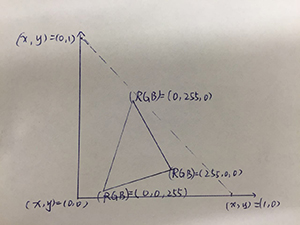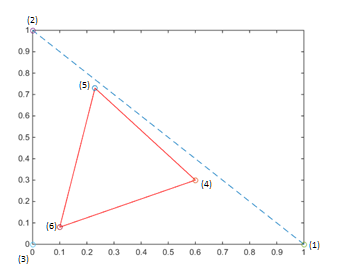| Line 61: | Line 61: | ||
\gamma=log_{\frac{R}{255}}{(R^{\alpha})}=\frac{ln{(R^{\alpha})}}{ln{\frac{R}{255}}}=\frac{\alpha{ln{R}}}{ln{R}-ln{255}} | \gamma=log_{\frac{R}{255}}{(R^{\alpha})}=\frac{ln{(R^{\alpha})}}{ln{\frac{R}{255}}}=\frac{\alpha{ln{R}}}{ln{R}-ln{255}} | ||
</math> | </math> | ||
| − | + | <span style="color:green"> <math>\gamma </math>gamma should be 1. </span> | |
b) | b) | ||
| Line 156: | Line 156: | ||
[[ Image:Pro1_2015_Aug.PNG ]]<br /> | [[ Image:Pro1_2015_Aug.PNG ]]<br /> | ||
| − | e) Gamma correction | + | e) Gamma correction a quantization will create an effect of dynamic range compression for pixels with small values. This will create dark block of shadings in a gradient region instead of a smooth transition. |
| − | + | ||
| − | + | ||
| − | + | ||
| − | + | ||
| − | + | ||
| − | + | ||
| − | + | ||
| − | + | ||
| − | + | ||
| − | + | ||
| − | + | ||
| − | + | ||
| − | + | ||
| − | + | ||
| − | + | ||
| − | + | ||
| − | + | ||
| − | + | ||
| − | + | ||
| − | + | ||
| − | + | ||
| − | + | ||
| − | + | ||
| − | + | ||
| − | + | ||
| − | + | ||
| − | |||
---- | ---- | ||
[[ECE-QE_CS5-2015|Back to QE CS question 1, August 2013]] | [[ECE-QE_CS5-2015|Back to QE CS question 1, August 2013]] | ||
[[ECE_PhD_Qualifying_Exams|Back to ECE QE page]]: | [[ECE_PhD_Qualifying_Exams|Back to ECE QE page]]: | ||
Revision as of 22:27, 3 December 2015
Contents
ECE Ph.D. Qualifying Exam in Communication Networks Signal and Image processing (CS)
August 2015, Part 1
- Part 1 , 2
Solution 1
a) $ \gamma=1 $
b)
$ \left( \begin{array}{c} X_r\\ Y_r \\ Z_r \end{array} \right)= \left( \begin{array}{ccc} a & b & c \\ d & e & f \\ g & h & i \end{array} \right) \left( \begin{array}{c} 1 \\ 0 \\ 0 \end{array} \right)= \left( \begin{array}{c} a \\ d \\ g \end{array} \right) $
So
$ (x_r,y_r)=(\frac{X_r}{X_r+Y_r+Z_r}, \frac{Y_r}{X_r+Y_r+Z_r})=(\frac{a}{a+d+g},\frac{d}{a+d+g}) $
Similarly
$ (x_g,y_g)=(\frac{b}{b+e+h},\frac{e}{b+e+h}) $,
$ (x_b,y_b)=(\frac{c}{c+f+i},\frac{f}{c+f+i}) $
c) The white point of the device is when the input $ [R, G, B] = [1, 1, 1] $
$ (x_w,y_w)=(\frac{a+b+c}{a+b+c+d+e+f+g+h+i},\frac{d+e+f}{a+b+c+d+e+f+g+h+i}) $
e) We are likely to see quantization artifact in dark region.
Solution 2:
a) $ \frac{R}{255}^\alpha=r_{linear}\\ \Rightarrow \gamma=log_{\frac{R}{255}}{(R^{\alpha})}=\frac{ln{(R^{\alpha})}}{ln{\frac{R}{255}}}=\frac{\alpha{ln{R}}}{ln{R}-ln{255}} $ $ \gamma $gamma should be 1. b)
$ P_r= \left( \begin{array}{ccc} a & b & c \\ d & e & f \\ g & h & i \end{array} \right) \left( \begin{array}{ccc} 1 \\ 0 \\ 0 \end{array} \right) = \left( \begin{array}{ccc} a \\ d \\ g \end{array} \right) \\ \Rightarrow x_r=\frac{a}{a+d+g} , y_r=\frac{d}{a+d+g} \\ P_g= \left( \begin{array}{ccc} a & b & c \\ d & e & f \\ g & h & i \end{array} \right) \left( \begin{array}{ccc} 0 \\ 1 \\ 0 \end{array} \right) = \left( \begin{array}{ccc} b \\ e \\ h \end{array} \right) \\ \Rightarrow x_g=\frac{b}{b+e+h} , y_g=\frac{e}{b+e+h} \\ P_b= \left( \begin{array}{ccc} a & b & c \\ d & e & f \\ g & h & i \end{array} \right) \left( \begin{array}{ccc} 0 \\ 0 \\ 1\end{array} \right) = \left( \begin{array}{ccc} c \\ f \\ i \end{array} \right) \\ \Rightarrow x_g=\frac{c}{c+f+i} , y_g=\frac{f}{c+f+i} $
c)
$ W= \left( \begin{array}{ccc} a & b & c \\ d & e & f \\ g & h & i \end{array} \right) \left( \begin{array}{ccc} 1 \\ 1 \\ 1\end{array} \right) = \left( \begin{array}{ccc} a+b+c \\ d+e+f \\ g+h+i \end{array} \right) \\ \Rightarrow x_g=\frac{a+b+c}{a+b+c+d+e+f+g+h+i} , y_g=\frac{d+e+f}{a+b+c+d+e+f+g+h+i} $
e) Gamma correction a quantization will create an effect of dynamic range compression for pixels with small values. This will create dark block of shadings in a gradient region instead of a smooth transition.



